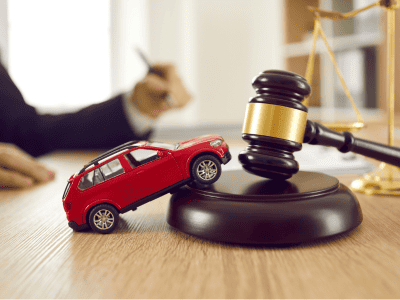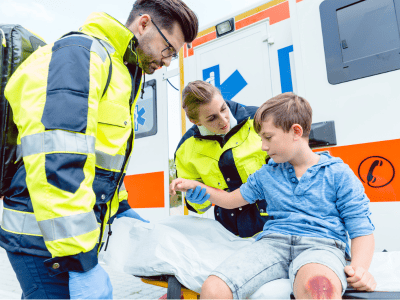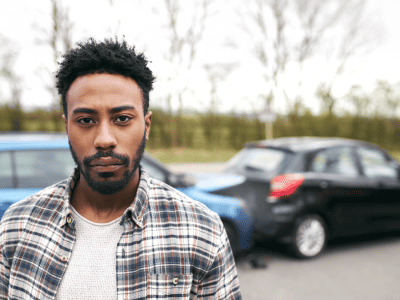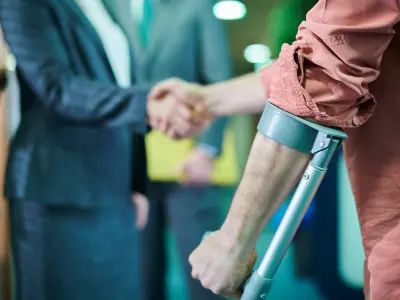4.9 Rating
Google REVIEWS
Leaders in Georgia Personal Injury Law Since 1995
Experienced Georgia Car Accident Lawyer | Legal Help for Auto Accident Victims
Car accidents are an unfortunate reality for many drivers, and the road to recovery can be riddled with legal and financial hurdles. When faced with this daunting journey, the support of a skilled Georgia car accident lawyer such as Scholle Law, can make all the difference. This blog post is your essential guide to finding the best Atlanta car accident lawyer and navigating the complexities of a car accident case. With the right legal professional by your side, you can tackle the challenges head-on and secure the compensation you deserve.
Key Takeaways
- A Georgia car accident lawyer can provide vital legal support to protect your rights and maximize compensation after an accident.
- An experienced attorney is necessary in Georgia car accidents for evidence collection, liability demonstration, damages calculation, and protection from insurance adjusters.
- Choosing the right attorney with experience, reputation & communication skills is essential to get the best representation within two years of filing a lawsuit.

Why You Need a Georgia Car Accident Lawyer
Suffering a car accident is a stressful and overwhelming experience. The aftermath can leave you feeling lost, unsure of how to protect your rights and secure the compensation you need. In these trying times, a seasoned Georgia car accident lawyer, for instance, an Atlanta car accident attorney, can provide vital support. Such professionals level the playing field while dealing with insurance adjusters, and guarantee maximum compensation for your injuries, while protecting your rights post-accident.
You can focus on your recovery while a skilled car accident lawyer guides you through the entire process. They can compile evidence to demonstrate the other party’s liability and represent your interests in court, securing the compensation you deserve. With the help of car accident lawyers, you can ensure that your case is handled professionally and efficiently.
Reach out to Butler Kahn, a reliable Georgia car accident attorney, for a free consultation if you’re looking for a dependable Georgia car accident lawyer.
Types of Car Accidents Handled by Georgia Car Accident Attorneys
Georgia car accident attorneys handle various accident types, ensuring that you receive the best legal representation regardless of the circumstances surrounding your case. Some common types of car accidents include rear-end collisions, head-on collisions, and side-impact (T-bone) crashes.
Rear-end collisions occur when one vehicle crashes into the back of another, often due to distracted driving or following too closely. Head-on collisions are particularly dangerous, as they involve two vehicles colliding with each other while traveling in opposite directions. Side-impact (T-bone) crashes occur when the front of one vehicle strikes the side of another, typically at intersections. In each of these cases, serious injuries can result, making a knowledgeable Atlanta car accident attorney indispensable to navigate the legal system’s complexities and safeguard your rights.
Furthermore, understanding Georgia’s fault-based system and the statute of limitations for car accident cases is vital for a successful outcome. Choosing the right Georgia car accident lawyer, with a specialization in personal injury and accident cases, can make all the difference.

Proving Liability in Georgia Car Accident Cases
Proving liability in a car accident case is critical to receiving the compensation you deserve. This process involves gathering evidence, interviewing witnesses, and demonstrating the at-fault party’s negligence. In many cases, liability hinges on the violation of the Rules of the Road, as most car accidents result from such infractions.
It’s crucial to collect evidence at the accident scene. Take photographs, obtain contact information from witnesses, and file a police report to establish a solid foundation for your case. With this evidence in hand, your Atlanta car accident attorney can help build a strong case demonstrating the other driver’s responsibility.
Nevertheless, dealing with insurance companies to prove liability can be a challenge. They may attempt to deny liability or reduce the amount of compensation you receive for your medical bills. This is where the expertise of an experienced car accident lawyer becomes invaluable, ensuring that your rights are protected and the appropriate compensation is secured.

Calculating Damages in Georgia Car Accident Claims
Assessing both economic and non-economic damages is involved in calculating damages in a car accident claim. Economic damages refer to quantifiable losses, such as medical expenses, property damage, and lost wages. These damages are relatively straightforward to calculate, as they have a direct monetary value.
Non-economic damages, on the other hand, compensate for intangible losses that are harder to quantify. These can include:
- physical pain and suffering
- mental anguish
- disruption of marital relationships
- loss of quality of life
Calculating non-economic damages is more subjective, requiring the expertise of a car accident attorney and, in some cases, leading injury and accident specialists to evaluate the value of the claim.
Investing time and resources into investigating these inquiries and obtaining correct answers with the assistance of lawyers and other professionals is crucial. This diligence ensures that you receive the full and fair compensation you deserve for both economic and non-economic damages.
Navigating Georgia’s Fault-Based System
Georgia operates under a fault-based system, where the driver deemed responsible for the accident is liable for the resultant damages. Their insurance company covers the costs up to the limits of the policy. This system has implications for car accident victims, as it determines the compensation they can receive.
Under Georgia’s modified comparative fault rules, an individual may still be eligible for compensation as long as they are not primarily responsible for causing the accident. However, if they share more than one-half of the blame for the accident, they may be barred from seeking damages. In cases where the victim is partially at fault, their recovery will be reduced in proportion to their share of responsibility. For example, if an individual is assigned 20 percent of the blame for the accident, they can receive up to 80 percent of their damages.
Navigating Georgia’s fault-based system and ensuring receipt of deserved compensation is easier with a skilled Atlanta car accident lawyer. They can help establish the degree of fault attributed to each party and advocate for your best interests throughout the process.

Common Challenges in Georgia Car Accident Cases
There are several common challenges in Georgia car accident cases, including proving liability, calculating damages, and dealing with insurance adjusters. These challenges underscore the need for a skilled Atlanta car accident attorney to represent your case. They can guide you through the complexities of the legal system and ensure that your rights are protected.
Proving liability can be particularly difficult, as you need to collect evidence demonstrating that the other driver was responsible. This may involve obtaining police reports, witness statements, and other forms of evidence. Additionally, the other driver’s insurance company may attempt to deny liability or reduce the amount of compensation you receive. A knowledgeable attorney can help safeguard your rights and ensure that you receive a reasonable settlement from the other driver’s insurance company.
Another challenge in car accident cases is calculating damages, which involves assessing both economic and non-economic damages. A car accident attorney can help evaluate the value of your claim and negotiate with the insurance company to secure a fair settlement. They can also consult with leading injury and accident experts to better understand your injuries and their potential long-term effects.

How a Georgia Car Accident Lawyer Can Help Protect Your Rights
A Georgia car accident lawyer, like those at Scholle Law, can significantly protect your rights and guide you through the legal process. They can assist in gathering evidence, such as interviewing witnesses, obtaining police reports, and collecting other pertinent documents. This evidence is critical in proving liability and establishing a strong case.
Moreover, an Atlanta car accident attorney can:
- Safeguard your interests by engaging in negotiations with insurance companies on your behalf
- Ensure that you receive the appropriate compensation for your injuries and damages
- Provide legal representation in court proceedings, including filing a lawsuit and presenting your case with the help of Atlanta car accident lawyers
An experienced car accident lawyer can prove invaluable in documenting the accident, collecting evidence, and pursuing legal assistance. By enlisting their help, you can focus on your recovery while they handle the legal complexities of your case.
Statute of Limitations for Georgia Car Accident Cases
In Georgia, the statute of limitations for filing a lawsuit related to a car accident is two years. This time limit begins from the date of the collision. This time constraint makes it crucial to act quickly and consult with a legal professional. Failing to file a claim within this period may result in forfeiting your right to seek any form of compensation.
In Georgia, addressing a car accident promptly is necessary not only to meet the statute of limitations but also to ensure the best possible outcome for your case. Gathering evidence, seeking medical treatment, and consulting with a car accident attorney are all time-sensitive tasks that should be addressed as soon as possible after the accident.
An experienced car accident attorney can assist in ensuring that the necessary deadlines are met for your case. They can guide you through the legal process, helping you gather evidence, calculate damages, and negotiate with insurance companies to secure the compensation you deserve.
Factors Affecting Car Accident Settlements in Georgia
In Georgia, car accident settlements are influenced by various factors, including the severity of property damage, injuries, and the degree of fault attributed to each party involved. Additionally, Georgia’s modified comparative negligence law plays a significant role in determining the amount of compensation a victim may receive.
Economic and non-economic damages also factor into the settlement amount.
- Economic damages, such as medical expenses and lost wages, are relatively straightforward to calculate.
- Non-economic damages, such as pain and suffering, involve a more subjective assessment.
- In cases involving severe injuries or extensive property damage, the settlement amount may be higher.
Working with an experienced car accident attorney is crucial to ensure you receive the full and fair compensation you deserve. They can help you:
- Navigate the complexities of Georgia’s fault-based system
- Gather evidence
- Negotiate with insurance companies on your behalf
- Ultimately secure the best possible outcome for your case.


Choosing the Right Georgia Car Accident Lawyer for Your Case
The crucial decision of selecting the right Georgia car accident lawyer for your case can significantly impact your claim’s outcome. When choosing a lawyer, consider their experience and established track record in handling car accident cases. A lawyer with a specialization in personal injury and accident cases will be better equipped to handle the unique challenges of your case.
Additionally, consider the attorney’s reputation, communication skills, and accessibility. A lawyer who is responsive to your needs and keeps you informed throughout the process can make a significant difference in your experience. Don’t hesitate to take advantage of free consultations when selecting a car accident lawyer.
Ultimately, the right Georgia car accident lawyer will be a knowledgeable, experienced, and compassionate advocate who is dedicated to representing your best interests and securing the compensation you deserve. By carefully considering these factors and taking the time to research and consult with potential attorneys, you can find the best legal representation for your case.
Summary
In conclusion, hiring a skilled Georgia car accident lawyer is essential for navigating the complexities of a car accident case and securing the compensation you deserve. From gathering evidence and proving liability to calculating damages and representing your best interests in court, an experienced attorney can make all the difference in the outcome of your case. As you embark on the road to recovery, don’t hesitate to seek the support of a dedicated Atlanta car accident attorney who will advocate for your rights and guide you through the challenging legal landscape.

Frequently Asked Questions
How much do Georgia car accident lawyers charge?
Most accident lawyers in Georgia charge on a contingency fee basis, with 33.33% pre-suit and 40% if the case goes to litigation.
What is the average settlement for an accident in Georgia?
The Insurance Information Institute reports that the average settlement for an accident in Georgia is $20,235. However, settlement amounts may range from as little as $2,500 up to $200,000 or more depending on the severity of the accident.
Can you sue for a car accident in Georgia?
You can sue for a car accident in Georgia within two years of the accident taking place. It is important to begin the legal process immediately to avoid any missed deadlines.
What to do if someone sues you for a car accident in Georgia?
If you are being sued for a car accident in Georgia, contact your car insurance company immediately. Be aware that you are entitled to free defense and that your insurance company will compensate you for any loss or damage. Make sure to find out what you are being sued for and write your insurance company a letter. Don’t rely on homeowners insurance.
What benefits can I expect from hiring a Georgia car accident lawyer?
By hiring a Georgia car accident lawyer, you can gain valuable assistance in navigating legal proceedings, negotiating with insurance companies, and maximizing your compensation.
